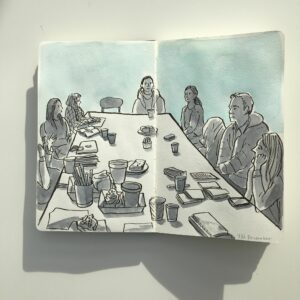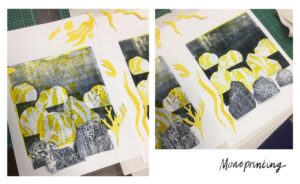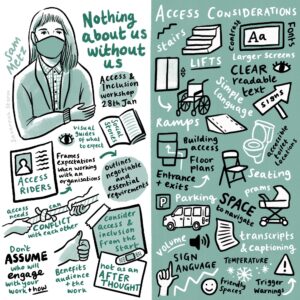Interview Feature With Savannah Storm
We sat down with illustrator Savannah Storm to talk about her time on the Coastal North Fellowship so far!

J: So I’m currently with Savannah Storm who is a local Scarborough based illustrator, who is
also one of the members of our Coastal North Fellowship Programme! Thank you very much
for being here and coming along for a quick chat.
So I think we could talk about your time in the fellowship so far and what you’ve been up to?
S: Yes sure! So far we’ve done one workshop and one research trip, as well as the general
introduction session at the start. It was great to meet Fran and all the other participants on
the programme, and hear about their practices and interests. I did a very quick sketch in the
initial meeting, I find they’re a good way for me to have a visual record of the day even
without writing any notes.
J: It’s good for looking in hindsight and reflecting on this kind of thing…
S: Yeah, people have been writing pages of notes from the sessions, there’s a lot of great
advice to take from them. Personally though if I write too many words I know I won’t read
them back and forget what I was thinking about, so sometimes sketching or making picture
notes is better for me!

S: For our first research trip we went to Leeds, which was a very busy day, we fit a lot of stuff
in! Firstly we met Julia from Threshold in the café at Leeds Art Gallery, and had a nice
informal chat about her work.
It was really interesting to hear her talk about how she approached funding for exhibitions;
she won a bid for a small amount of funding and used that start work on the project, then
applying for a bigger amount of funding using this work, like stepping stones until she had
enough to fund the exhibition.
She explained it way better than I did! One key thing I remember she said was that the
budget needs to tell a story, which framed it nicely in my mind.
J: You went to Leeds print workshop as well didn’t you?
S: Yeah, that was right at the end of the day, which was so nice because I find cities quite
overwhelming in general. So just sitting down and doing something creative and quite
mindful was a great way to round off the day.
We did mono-printing using collage, cutting out shapes and layering them with different ink
layers to create different effects. I miss the print workshop from when I was at uni, it was
nice to have access to the equipment and space to play with new printing techniques.
J: Yeah, I bet it’s good to actually have the opportunity to access these facilities.
S: It was interesting to go into it with no real plan and just make whatever we liked, it
reminded me how much I enjoy printmaking, I definitely want to use it more in the future.
Mine was rockpool themed, with teal and yellow ink layers, and I cut out seaweed and fish
and scrunched up paper for the rock textures.
J: Oh wow how beautiful!
S: Looking at what I made, I kind of want to transfer this to fabric and do some stitching over
the top? I did used to enjoy some freehand embroidery on a sewing machine, using thread
drawing.
J: Yeah, it’s quite interesting that you can get that inspiration from the print workshop
because it’s leading you onto new ideas and different pathways.
S: I definitely feel inspired now to explore these ideas further, and try some of those
practises that I did it at college again. As an illustrator I do a lot of briefs for client and digital
work, so it would be interesting to try more printmaking art alongside my usual work.
Overthinking is the biggest killer of creativity for me, as well as narrowing myself down too
much. Staying loose and experimental keeps my work feeling more fresh.

J: So that was your first trip, and then it was after that you had your first workshop session
with Sam Metz?
S: Yes the workshop last week was about access and inclusion in spaces and events, which
I had some background knowledge on as I did some visual note-taking at talks about similar
subjects with Scarborough Museums in the past, as well as creating social stories for some
of their exhibitions too.
Sam covered lots new things that I didn’t know, and it was great to hear about the subject
from another viewpoint. One activity was to create our own social story, which are visual
guides to aid accessibility, like a document or video people can see before visiting a venue
or event so they know what to expect. It can be really useful to ensure that disabled and
neurodivergent people can be included!
They made a good point to not assume who is going to read it your social story because it
can be really useful to lots of different people. For example, flagging up that one of the doors
to the building was really heavy and hard to open could be useful information for someone
with stamina issues, parents with prams, or wheelchair users.
In the activity to make our own social story we considered access to the building, starting
from outside and working our way through to the correct room. We discussed possible
issues such as tight corridors, ramps or ridges in the floor, and clear, readable signage.
I think it’s good to put yourself in the mind of someone who doesn’t necessarily have the
same abilities as you and thinking about what they might struggle with.
S: Some key takeaways were to not assume who will engage with your work in an exhibition
setting and how, and the importance of considering access and inclusion from the beginning
rather than as a quick fix at the end.
It made me reflect back on my previous work on creating illustrated social stories, I wasn’t
sure whether to include them in my portfolio, but the workshop with Sam really made me
realise how useful and worthwhile they are, and I think more venues and events should have
them!

J: Then the second half of the day was spent with David Cleary from Mostyn Gallery.
S: Yeah, we discussed proposal writing, and knowing where you fit in the arts sector. This is
definitely something I struggle with, it’s sometimes hard to articulate exactly where you sit as
things like art, design and illustration all overlap so much. Especially as a freelancer as you
can be working on a range of different projects at the same time, so it’s hard to pinpoint what
your specialism is.
We did quite a few activities to make us think about the key parts of our practices, one was
pairing up and talking about what we create for 1 minute, and then our partner had to write
us an artist bio. It was interesting to hear how they came out, and helpful to have a fresh
perspective on your work! Especially as many of us don’t have studios and peers around us
constantly to bounce ideas off of, it was great to think more collaboratively.
J: Have you begun to think about what you might take into future sessions, or how what
you’ve already done that will help you to approach projects and creative work in the future?
S: I think all the advice and inspiration so far has been great, and it’s useful to have practical
workshops to inform your own practice a bit more. I’m feeling more inspired about creating
sketch notes and visualising information, as well as experimenting with printmaking some
more!
Also it’s got me wanting to collaborate more with others, as having this network of peers to
talk to about projects and share ideas and inspiration with is so great. After a lot of time
spent working in a quite isolated way, it’s so nice to have a little community forming!
J: Thank you so much for coming in to do this Savannah, great to hear about everything
that’s going on behind the scenes.
Join our mailing list
Stay up to date with our current and forthcoming programme, exhibition and events.
We don't share your information with anyone else.
